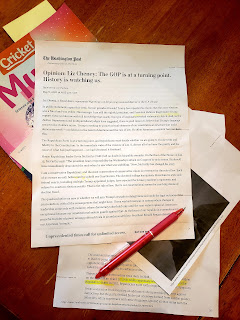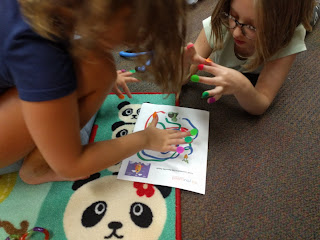Using Current Events in The Teaching of Reading, Writing, and Analyzing Opinion Non-Fiction
Our 7th grader and I have been doing a deep dive into opinion texts. It seemed to me an excellent time to delve into my son's interest in current events while learning how opinion writers organize their ideas and differentiate their voice among all the voices in the field. After having spent the first half of our school year reading a great deal of dystopian fiction, my son experiences intellectual urgency when thinking and learning about government, ethics, politics, and the individual. He grapples with the information he hears on the news and that he and his friends joke about among themselves. He is in that fantastic time when he can still be a child and just play at having opinions and ideas without experiencing too many high stakes consequences. He is still learning the facts about how our world and politics function while also learning how to think critically about those functions. It's an exciting learning time, and I am so happy and lucky to navigate these waters with him.
Since we follow the Common Core Learning Standards, our goals for this week have been to note how authors state viewpoints, differentiate their views, and organize their ideas. (RI 7.6, RI 7.5, RI 7.9)
We began by exploring patterns of organization authors use and read several articles from his Muse magazine subscription, identifying articles using chronological order, lists, comparison/contrast structures, cause and effect structures, definition and example patterns, classification organization, order of importance, problem and solution structures, spatial order, and articles with a mix of two or more patterns. Thus, he had a foundation of exploring these patterns within writing intended for younger audience.Then we were ready to move into more complex texts that grapple with difficult topics. We read two opinion articles about the division playing out within America's Republican party, analyzing the organizational structures as well as the language the authors use to identify their views and how those views differ from others'.
We started with Liz Cheney's May 5th Op Ed published in The Washington Post.
We noted her strong position statement, "The Republican Part is at a turning point, and Republicans must decide whether we are going to choose truth and fidelity to the Constitution."
We also noted the more complex mixture of two organizational structures. Overall, Cheney's piece is organized with a problem/solution pattern, laying out a problem she views within the Republican party in the first five paragraphs and offering solutions in the remaining paragraphs before closing with a plea to her fellow party members. My son noted she organized her solutions within a chronological order.
Then, we moved into examining Leonard Pitts Jr's May 7th Op Ed in the Miami Herald "Rep. Liz Cheney told the truth. Her Republican colleagues can't handle it."
I asked my son to delve into this one more on his own, and he noted the very strong language Pitts uses to state his main viewpoint, "In 2016, white supremacy was elected president on the Republican ticket. In 2021, Republicans scarf cattle droppings like buttered popcorn."
He also noted that Pitts' piece is organized by multiple cause/effect pairings, listing several causes followed by their effects (Cheney's stances and then their consequences for her politically) and then tracing the longer rooted causes of those consequences (as far back as New Gingrich's warfare approach to politics) followed by a future possible effect, "writing an epitaph for this democracy."
I hope my fellow homeschoolers are finding opportunities to explore published pieces with their children, examining writing published outside the academic realm for its craft, structure, and role in the world's discourse. And, as always, I hope anything I share might be of some use to someone.


Comments
Post a Comment